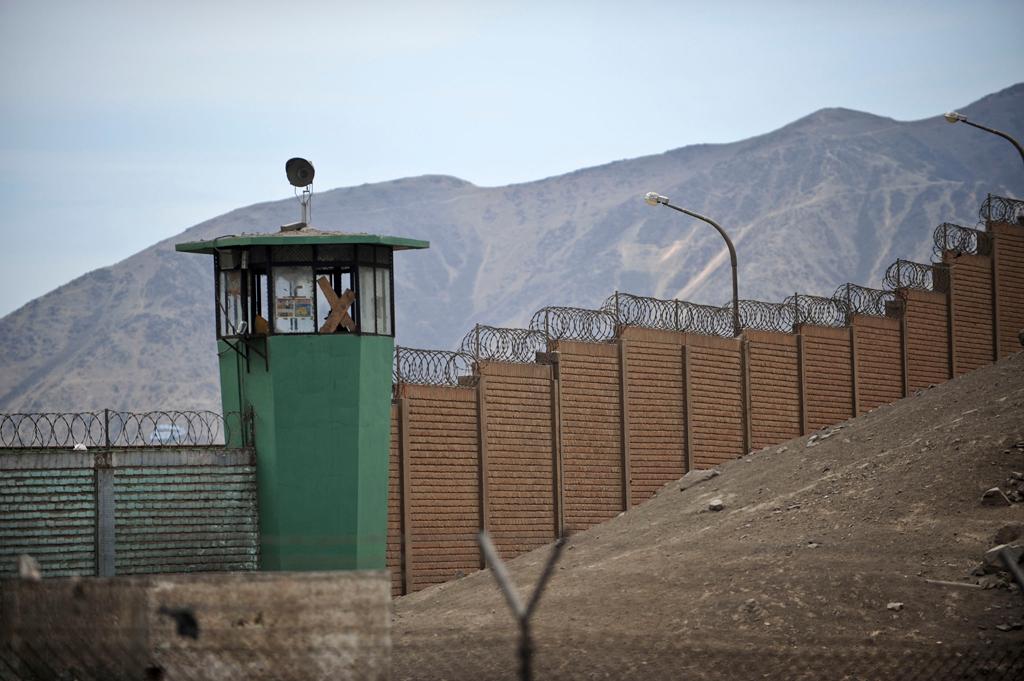Peru prison: from pot smoke to pottery class
The fence and surveillance tower of the San Juan de Lurigancho prison in Lima, Peru’s largest prison.
LIMA, Peru — Salsa blares from the cells and the pungent smell of cannabis smoke hangs in the air.
In the crowded, dingy corridors, prisoners cook lunch on tiny electric stoves, play cards and shoot the breeze. Tattooed, shirtless men hurry by, barely stopping as they exchange greetings.
One inmate pours me a shake from his blender. Made from a uniquely Peruvian mix of quinoa, oatmeal, banana, honey and cacao — it is delicious.
I am inside Lurigancho, Peru’s largest prison, reputedly one of the toughest in South America. Built to house 2,500, its grimy, crumbling wings are currently home to some 7,000 inmates.
Other than sex offenders, there is no segregation. Hardened career criminals and violent offenders freely mingle with youngsters locked up for stealing a pair of sneakers.
Prisoners wear their own clothes and, from 6 a.m. to 6 p.m., are free to wander almost wherever they want in the jail.
Most are Peruvians but there is also a smattering of foreigners, everything from Americans to Africans. Many are cocaine mules — a low-profit, high-risk crime only committed by the desperate or the desperately stupid.
Read more: In-depth series on Latin America's prison problems
Outside the wing, in the “market,” entrepreneurial convicts hawk everything from second-hand clothes and pirate DVDs to fresh fruit and vegetables. One hires out cell phones, supposedly prohibited inside the jail.
Above us, on the roof of the wing, fighting cocks cluck and strut inside their pens.
Nearby, two prostitutes haggle with several inmates. Today is a men-only visitors’ day but they have managed to get in somehow to service what must surely be the ultimate captive market.
“Nurses,” an inmate grins, when I ask him about the women. “A social service,” another explains, adding: “This place would explode without them.”
It would not be the first time.
In 1986, Lurigancho and two other Peruvian prisons rioted. Taken by surprise, the government responded with indiscriminate violence, according to Peru’s official Truth and Reconciliation Report.
At Lurigancho, police were responsible for the extra-judicial killings of more than 90 inmates, the report states.
That notorious incident has given rise to Lurigancho’s lurid reputation. National Geographic has even erroneously blamed most of those deaths on the prisoners themselves, using it to justify labeling Lurigancho as “one of South America’s toughest prisons.”
The truth is more prosaic but no less fascinating.
Shocking acts of violence do occur here — including the recent case of a Dutch inmate who killed his Peruvian girlfriend and then entombed her below his cell’s concrete floor.
More from GlobalPost: No escapting Peru's drug rehab fires
Yet most prisoners here are not dangerous. Otherwise, allowing them to move largely unhindered around the jail would be impossible. And Lurigancho would require far more than the 150 police officers who currently staff it.
The inmates I spoke with were nothing but courteous and friendly — and eager to explain how they were rebuilding their shattered lives. That included giving me a tour of the pottery and weaving workshops where they are mastering vocational skills as well as making products that are marketed as far away as Japan. (Pictured here are some of the prisoners' crafts. The Santa Claus-looking figure is known as an "equeco" and brings good luck.)
![]()
Yet what is truly shocking is the rampant, brazen corruption of the guards.
To enter Lurigancho, you have to pass multiple checks. The police officer at each barrier openly, shamelessly demands a bribe from me, usually “for a soft drink.”
Once inside, I spot another officer at an internal checkpoint demanding cash from inmates to allow them to move from one area of the jail to another. “They are the biggest crooks here,” a convict says in disgust.
Jose Avila, head of the prisons program at the Defensoria del Pueblo, Peru’s official human rights ombudsman, says corruption pervades the prison system.
“Corruption is very serious because if you have alcohol, drugs, arms and other forbidden objects, as well as unauthorized people, entering a jail, it puts the entire prison population at risk,” he told GlobalPost.
Other woes highlighted by Avila include the fact that Peru’s prison population of 50,000 is roughly 70 percent more than the planned capacity of its 66 jails, with Lurigancho the most overcrowded of the lot.
Meanwhile, there are just 23 doctors to care for those prisoners. Predictably perhaps, the rate of TB among jail inmates is 20 times higher than outside.
Another problem is that the prisons authority, INPE, largely fails to meet its statutory obligation to provide opportunities for rehabilitation. The vast weaving and pottery workshops I saw were set up by a nonprofit group founded by a Catholic activist and funded by foreign aid.
According to the inmates, INPE has even attempted to shutter the workshops. Meanwhile, corrupt officials charge to let raw materials such as clay or wool into Lurigancho and finished products out to market.
More from GlobalPost: Latin America’s hidden growth story
INPE declined GlobalPost’s request for an interview with its head, Jose Luis Perez.
In a country where many still live in grinding poverty, few are willing to argue for more resources for convicted criminals. Meanwhile, most fail to last long enough in Perez’s challenging job to make any real impact.
“There are always going to be escapes or a riot within the first few months of someone taking up the job,” Leonardo Caparros, a former acting head of INPE, told GlobalPost.
“There needs to be a political commitment to the president of INPE to give him time and protection. Otherwise some in the media will sensationalize what has happened, the president will lose his job and we will just be back to square one.”
